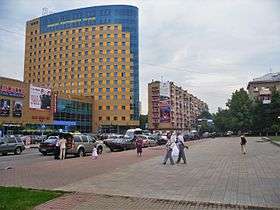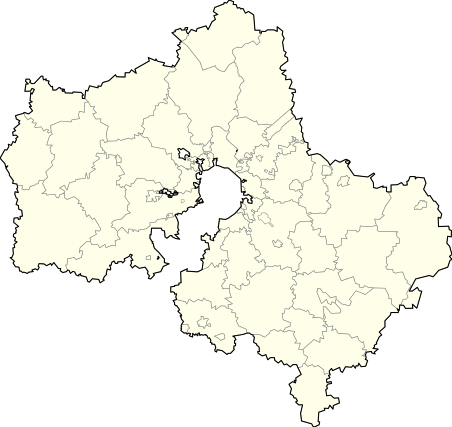Balashikha
| Balashikha (English) Балашиха (Russian) | |
|---|---|
| - City[1] - | |
 Lenina Avenue | |
.svg.png) Location of Moscow Oblast in Russia | |
 Balashikha | |
|
| |
_(1999).png) |
|
|
| |
| Administrative status (as of December 2014) | |
| Country | Russia |
| Federal subject | Moscow Oblast[1] |
| Administratively subordinated to | Balashikha City Under Oblast Jurisdiction[1] |
| Administrative center of | Balashikha City Under Oblast Jurisdiction[1] |
| Municipal status (as of January 2015) | |
| Urban okrug | Balashikha Urban Okrug[2] |
| Administrative center of | Balashikha Urban Okrug[2] |
| Head | Vladimir Samodelov |
| Representative body | Council of Deputies |
| Statistics | |
| Area (urban okrug) (July 2012) | 244.18 km2 (94.28 sq mi)[2] |
| Population (2010 Census) | 215,494 inhabitants[3] |
| - Rank in 2010 | 86th |
| Density | 883/km2 (2,290/sq mi)[4] |
| Time zone | MSK (UTC+03:00)[5] |
| Founded | 1830[6] |
| City status since | 1939 |
| Postal code(s)[7] | 143xxx |
| Dialing code(s) | +7 495 |
|
| |
| Balashikha on Wikimedia Commons | |
Balashikha (Russian: Балашиха; IPA: [bəlɐˈʂɨxə]) is a city in Moscow Oblast, Russia, located on the Pekhorka River 1 kilometer (0.62 mi) east of Moscow. Population: 215,494 (2010 Census);[3] 147,909 (2002 Census);[8] 135,841 (1989 Census);[9] 92,400 (1970).
Etymology
Balashikha is an unusual name in Russian and several legends exist as to why it was chosen as the name of this conurbation. The word balash is Turkic and can be translated as an inn, i.e., a place of temporary respite for travelers. Another account tells of a wealthy Tatar, named Balash, a descendant of Genghis Khan of the Golden Horde who had his residence on this site. Most usual explanation is that it derived from word balakh, which means caltha palustris plant. Another version: in finno-ugric languages Bala-shika means land of celebrations, land of laughter and fun.[10] Before Slavs in this area lived Finno-Ugric peoples.
Geography
The city is known for its unique river and waterway system. The Pekhorka River system covers an area of 40 kilometers (25 mi) from north to south and 20 kilometers (12 mi) from east to west, and many small lakes and ponds were created by damming to provide water power for the cotton mills in the 19th century.
History
Balashikha was established in 1830.[6] It was granted town status in 1939.[11] Several rural hamlets had existed long before on the site of the modern city.
The city stands on the famous Vladimir Highway, which led out of Moscow to the east. This was the route along which convicted criminals were marched to forced labor camps in Siberia. The road was renamed Gorky Highway in the Soviet era. The failure of the Decembrist Revolt against Tsar Nicholas I led to the execution of its ringleaders and the exile of many nobles to Siberia. Soviet-era schoolchildren were told that the prisoners were marched in chains along this road followed by their wives. In truth, the Decembrist prisoners were sent from St. Petersburg, then the capital of Russia, through Yaroslavl, and not through Moscow and Balashikha, and the story was invented as part of celebrations of the 100th anniversary of the event in 1925.
Between 1830 and 1870, a cotton factory was in operation in the area, with its fabric called Balashikha. A railway station was built at the end of the 19th century, again called Balashikha Station.
As it grew, Balashikha absorbed other villages, including Gorenki, a suburban estate of Count Andreas Razumovsky, and Pekhra-Yakovlevskoye, an estate of Prince Galitzine, the latter being in use for 250 years from 1591 to 1828. This is the site of a stone church, built from 1777 to 1782.
Saltykovka, a part of Balashikha, has long been known for its attractions to the artistic community. Isaak Levitan, the famous landscape painter, lived there in 1879. Lev Tolstoy was another frequent visitor.
Soviet period
Several institutions were founded in Balashikha after the October Revolution, including one dedicated to the production of fur.
During the Soviet era, Balashikha became a major industrial center with industries in metallurgy, aviation industry, cryogenic technology, machinery, and other fields.
Balashikha sent many of its sons to the front to fight the Germans during World War II. Among those who fought and died was Ivan Flerov who commanded a Katyusha rocket division and is remembered by several monuments and museums in the area.
Along with many other Russian Orthodox Churches, the Cathedral of Saint Alexander Nevsky was demolished by the government. The Cathedral was blown up in the 1960s but was rebuilt, on its original site, in 2002.
Modernity
The Balashikha Maternity House was designated on July 1, 2003, to be the Moscow Oblast Perinatal Center. This facility will now function as a regional perinatal care facility for high-risk mothers and infants and a perinatal health education center for Moscow Oblast.
Although not part of the extensive Moscow subway system, Balashikha is home to many office workers who commute to Moscow each day. It has several thriving markets and retail centers and is quickly modernizing. It is surrounded by attractive woodland and countryside.
In January 2015, the city of Zheleznodorozhny was abolished with its territory merged into Balashikha.
Administrative and municipal status
Within the framework of administrative divisions, it is, together with twelve rural localities, incorporated as Balashikha City Under Oblast Jurisdiction—an administrative unit with the status equal to that of the districts.[1] As a municipal division, Balashikha City Under Oblast Jurisdiction is incorporated as Balashikha Urban Okrug.[2]
In the past, Balashikha served as the administrative center of Balashikhinsky District. On January 1, 2011, the district was abolished.
Culture

The city is home to several music schools, including the Sviridov School of Arts. Attractions include the Balashikha Arena and Moscow Radio Center 13.
Military
Balashikha is the site of a large Russian Army base and was closed to foreigners during the Soviet era, a ban which, in theory, remains to the present day. It was the headquarters of the 1st Corps of the Soviet Air Defense Forces and is now to become the headquarters of the Operational-Strategic Command for Missile-Space Defense.
Notable people
- Yuri Lyapkin, ice hockey player
- Nikolay Baskov, tenor singer
- Dmitry Klokov, Honored Master of Sports in Weightlifting
Twin towns and sister cities
Balashikha is twinned with:
References
Notes
- 1 2 3 4 5 Law #11/2013-OZ
- 1 2 3 4 Law #208/2014-OZ
- 1 2 Russian Federal State Statistics Service (2011). "Всероссийская перепись населения 2010 года. Том 1" [2010 All-Russian Population Census, vol. 1]. Всероссийская перепись населения 2010 года (2010 All-Russia Population Census) (in Russian). Federal State Statistics Service. Retrieved June 29, 2012.
- ↑ The value of density was calculated automatically by dividing the 2010 Census population by the area specified in the infobox. Please note that this value may not be accurate as the area specified in the infobox does not necessarily correspond to the area of the entity proper or is reported for the same year as the population.
- ↑ Правительство Российской Федерации. Федеральный закон №107-ФЗ от 3 июня 2011 г. «Об исчислении времени», в ред. Федерального закона №271-ФЗ от 03 июля 2016 г. «О внесении изменений в Федеральный закон "Об исчислении времени"». Вступил в силу по истечении шестидесяти дней после дня официального опубликования (6 августа 2011 г.). Опубликован: "Российская газета", №120, 6 июня 2011 г. (Government of the Russian Federation. Federal Law #107-FZ of June 31, 2011 On Calculating Time, as amended by the Federal Law #271-FZ of July 03, 2016 On Amending Federal Law "On Calculating Time". Effective as of after sixty days following the day of the official publication.).
- 1 2 Энциклопедия Города России. Moscow: Большая Российская Энциклопедия. 2003. p. 35. ISBN 5-7107-7399-9.
- ↑ Почта России. Информационно-вычислительный центр ОАСУ РПО. (Russian Post). Поиск объектов почтовой связи (Postal Objects Search) (Russian)
- ↑ Russian Federal State Statistics Service (May 21, 2004). "Численность населения России, субъектов Российской Федерации в составе федеральных округов, районов, городских поселений, сельских населённых пунктов – районных центров и сельских населённых пунктов с населением 3 тысячи и более человек" [Population of Russia, Its Federal Districts, Federal Subjects, Districts, Urban Localities, Rural Localities—Administrative Centers, and Rural Localities with Population of Over 3,000] (XLS). Всероссийская перепись населения 2002 года [All-Russia Population Census of 2002] (in Russian). Retrieved August 9, 2014.
- ↑ Demoscope Weekly (1989). "Всесоюзная перепись населения 1989 г. Численность наличного населения союзных и автономных республик, автономных областей и округов, краёв, областей, районов, городских поселений и сёл-райцентров" [All Union Population Census of 1989: Present Population of Union and Autonomous Republics, Autonomous Oblasts and Okrugs, Krais, Oblasts, Districts, Urban Settlements, and Villages Serving as District Administrative Centers]. Всесоюзная перепись населения 1989 года [All-Union Population Census of 1989] (in Russian). Институт демографии Национального исследовательского университета: Высшая школа экономики [Institute of Demography at the National Research University: Higher School of Economics]. Retrieved August 9, 2014.
- ↑ Топонимия Балашихи.
- ↑ Balashikha. Official page. History.
Sources
- Московская областная Дума. Закон №11/2013-ОЗ от 31 января 2013 г. «Об административно-территориальном устройстве Московской области», в ред. Закона №72/2015-ОЗ от 5 мая 2015 г. «Об отнесении города Озёры Озёрского района Московской области к категории города областного подчинения Московской области, упразднении Озёрского района Московской области и внесении изменений в Закон Московской области "Об административно-территориальном устройстве Московской области"». Вступил в силу на следующий день после официального опубликования (13 января 2013 г.). Опубликован: "Ежедневные Новости. Подмосковье", №24, 12 февраля 2013 г. (Moscow Oblast Duma. Law #11/2013-OZ of January 31, 2013 On the Administrative-Territorial Structure of Moscow Oblast, as amended by the Law #72/2015-OZ of May 5, 2015 On Re-Classifying the Town of Ozyory in Ozyorsky District of Moscow Oblast as the Town Under Oblast Jurisdiction, on Abolishing Ozyorsky District of Moscow Oblast, and on Amending the Law of Moscow Oblast "On the Administrative-Territorial Structure of Moscow Oblast". Effective as of the day following the day of the official publication (January 13, 2013).).
- Московская областная Дума. Закон №208/2014-ОЗ от 30 декабря 2014 г. «О преобразовании городского округа Балашиха и городского округа Железнодорожный, о статусе и установлении границы вновь образованного муниципального образования», в ред. Закона №52/2015-ОЗ от 13 апреля 2015 г. «О внесении изменения в Закон Московской области "О преобразовании городского округа Балашиха и городского округа Железнодорожный, о статусе и установлении границы вновь образованного муниципального образования"». Вступил в силу через 10 дней после официального опубликования, за исключением статей 4 и 5, вступающих в силу через один месяц после вступления в силу настоящего Закона в случае отсутствия инициативы жителей Городского округа Балашиха о проведении местного референдума по вопросу определения структуры органов местного самоуправления Городского округа Балашиха. Опубликован: Официальный Интернет-портал Правительства Московской области (http://www.mosreg.ru), 30 декабря 2014 г. (Moscow Oblast Duma. Law #208/2014-OZ of December 30, 2014 On Transforming the Urban Okrug of Balashikha and the Urban Okrug of Zheleznodorozhny, on the Status and the Border of the Newly Established Municipal Formation, as amended by the Law #52/2015-OZ of April 13, 2015 On Amending the Law of Moscow Oblast "On Transforming the Urban Okrug of Balashikha and the Urban Okrug of Zheleznodorozhny, on the Status and the Border of the Newly Established Municipal Formation". Effective as of the day which is 10 days after the official publication, with the exception of Articles 4 and 5, which take effect one month after this Law takes effect, providing the lack of initiative of the urban okrug residents to conduct a local referendum on the subject of establishing the structure of the bodies of local self-government of Balashikha Urban Okrug.).
Further reading
- "Balashikha in stories" (Балашиха в очерках и зарисовках) - А. Галанин и др.
External links
| Wikimedia Commons has media related to Balashikha. |
- Official website of Balashikha (Russian)
- Unofficial website of Balashikha (Russian)